Questions
- Two masses of 3kg and 7kg are connected by a light string. The 3 kg mass rests on a smooth incline plane 300 to the horizontal. The 7 kg mass hangs freely from the frictionless pulley attached to the top of plane.
- Draw a diagram showing the bodies and identify the forces acting on the 3 kg mass.
- Calculate the acceleration of the masses.
- A rocket propelled upward with a constant thrust. Assuming friction due to air is negligible and the burning of the fuel is steady. Explain its motion.
- A 2 kg body slides down a smooth slope from a height of 5m. As it reaches the horizontal, it strikes another body of mass 3 kg which is at rest. Both bodies stick together. Calculate the velocity of the bodies after collision.
- A girl of mass 40 kg stands on a scale balance in a lift. The lift is accelerating upwards. At one instant the acceleration of the lift is 2 m/s. Calculate the reading on the scale at that instant.
- The diagram below shows a tall measuring cylinder containing a viscous liquid. A very small steel ball is released from rest at the surface of the liquid as shown.
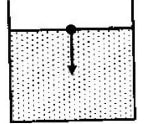
Sketch the velocity- time graph for the motion of the ball from the time it is released to the time just before it reaches the bottom of the cylinder. - A body of mass 5 kg is ejected vertically from the ground when a force of 600N acts on it for 0.1s. Calculate the velocity with which the body leaves the ground.
-
-
- A body is initially in motion. If no external force acts on the body, describe the subsequent motion.
- A car of mass 800 kg is initially moving at 25 m/s. Calculate the force needed to bring the car to the rest over a distance of 20 m.
- Two trolleys of masses 2 kg and 1.5 kg are traveling towards each other at 0.25 m/s and 0.40 m/s respectively. Two trolleys combine on collision.
- Calculate the velocity of the combined trolleys.
- In what direction do the trolleys move after collision?
-
-
- The diagram below shows a block of mass 5 kg sliding down from rest on a plane incline at an angle of 300 to the horizontal. A frictional force of 6N acts between the block and the plane.
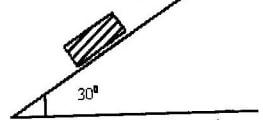
- Copy the diagram and show the forces acting on the block.
- Calculate the resultant force on the block.
- Calculate the time taken by the block to cover the distance of 25cm.
- The table shows the value of the resultant force, F, and the time t for a bullet traveling inside the gun barrel after the trigger is pulled.
Force, F (N) 360 340 300 240 170 110 Time, (t) (milliseconds) 3 4 8 12 17 22 - Plot a graph of Force, f against time t.
- Determine from the graph.
- The time required for the bullet to travel the length of the barrel assuming that the force becomes zero just at the end of the barrel.
- The impulse of the force.
- Given that the bullet emerges from the muzzle of the gun with a velocity of 200 m/s, calculate the mass of the bullet.
- The diagram below shows a block of mass 5 kg sliding down from rest on a plane incline at an angle of 300 to the horizontal. A frictional force of 6N acts between the block and the plane.
- The diagram below shows two identical strings A and B attached to a large mass M. String A is attached to the ceiling. State the reason why string B cuts when its free and is suddenly pulled downward.

- The figure below shows a 2 kg block attached to 0.5 kg mass by a light inextensible string which passes over a pulley. The force of friction between the horizontal bench and block is 3N. The block is released from rest so that both masses move through a distance of 0.6m. Calculate the velocity of the string.
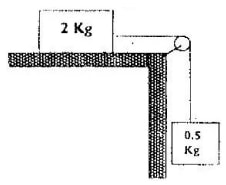
- A trolley is moving at constant speed in a friction compensated track. Some plasticine is dropped on the trolley and sticks to it. State with a reason what is observed about the motion of the trolley.
- The figure below shows a block of mass 30.0 kg being pulled up a slope by force P at a constant speed. The frictional force on the block is 20.0N

-
- On the same figure name and indicate other forces acting on the block.
- Determine the component of the weight acting on the trolley down the slope
- Determine the value of P.
- On reaching the top of the slope, the block is left to run freely down the slope.
- Which one of the forces previously acting on the block would then act in the opposite direction?
- Determine the acceleration of the block down slope.
- What is the effect of increasing the angle of slope on your answer in (ii) above?
-
- A high jumper usually lands on a thick soft mattress. Explain how the mattress helps in reducing the force of impact.
- A resultant force F acts on a body of mass m causing an acceleration a1 on the body. When the same force acts on a body of mass 2m, it causes an acceleration a2. Express a2 in terms of a1.
-
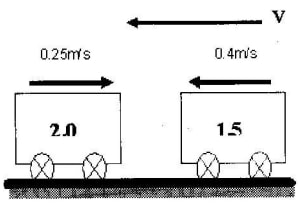
The figure above shows two trolleys of mass 2.0 kg and 1.5 kg traveling towards each other at 0.25 m/s and 0.4 m/s respectively. The trolleys combine on collision. Calculate the velocity of the combined trolley and show the direction in which they move after collision. - Two identical stones A and B are released from the same height above the ground. B falls through air while A falls through water. Sketch the graphs of kinetic energy (KE) against time (t) for each stone. Label the graph appropriately.
- A trolley is moving at uniform speed along a track. A piece of plasticine is dropped on the trolley and sticks on it. Explain why the trolley slows down. (2 mks)
-
- State the Newtons law of motion. (1 mk)
- A wooden block resting on a horizontal bench is given an initial velocity, u, so that it slides on the bench surface for a distance, d, before coming to a stop. The values of d were measured and recorded for various values of initial velocity. The figure below shows the graph of u2 against d.
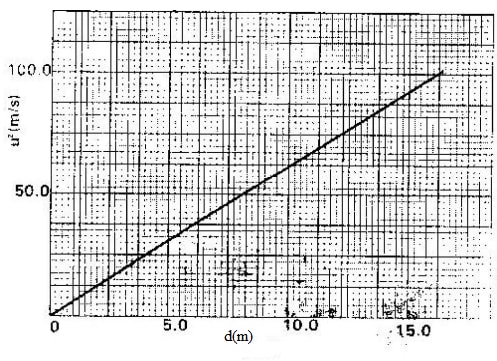
- Determine the slope, s, of the graph
- Given that u2 = 20kd, where k is a constant for the bench surface, determine the value of k from the graph.
- State how the value of k would be affected by change in the roughness of the bench surface.
- A car of mass 800kg starts from the rest and accelerates at 1.2ms-2. determine its momentum after it has moved 400m from the starting
- A force of 6N acts on a 2kg trolley and accelerates at 2 m/s2. Calculate the retarding force acting on the trolley.
- A boulder is sliding down a slope, with a uniform acceleration of 3 ms-2; calculate its velocity after it has slid 10m down the slope.
- A man whose mass is 70 kg stands on a spring weighing machine. When the lift starts to ascend its acceleration is 2.45m/s2. What is the reading on the scale?
- A bullet of mass 22 g traveling at a velocity of 18 m/s penetrates a sand bag and is brought to rest in 0.6 seconds. Find:
- The depth of penetration in metres
- The average retarding force of the sand
- A bullet of mass 10g traveling horizontally with a velocity of 300 m/s strikes a block of wood of mass 290g which rests on rough horizontal floor. After impact they move together and come to rest after traveling a distance of 15m. Calculate
- the common velocity of the bullet and the block.
- the acceleration of the bullet and the block.
- the coefficient of sliding friction between the block and the floor.
-
- A body of mass m initially at rest is acted on by a force F for a time t, as a result its velocity changes to a final value V. Use this information to show that the gain is kinetic energy E= ½ MV2
- Calculate the kinetic energy of a car of mass 1000 kg traveling at 36 km/h
- Under a driving force of 400N a car of mass 1250 kg has an acceleration of 2.5 m/s. Find the frictional force acting on the car.
- An apple of mass 100g falls a distance of 2.5m to the ground from a branch of a tree.
- Calculate the speed at which it hits the ground and the time taken for it to fall. (Ignore air resistance).
- Assuming the apple takes 100 milliseconds to come to rest. Calculate the average force experienced by the apple.
- A helicopter of mass 3000 kg rises vertically at a constant speed of 25 ms-1 if the acceleration due to gravity is 10 ms-2; determine the resultant force working on the helicopter
Answers
-
-
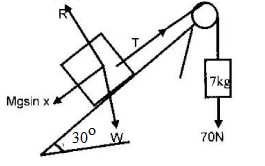
R - Reaction
W - Weight
T - Tension - Net force= 70N – mgsinx= 70N- 30×sin 30
F= ma
55= (7 + 3) a
a= 5.5m/s2
-
- The rocket will accelerate due to 2 reasons
- The total mass of the rocket decreases as the fuel burns but thrust force is constant
- The gravitational pull decreases with increase in distance from the centre of the earth so it will be less.
- P.E = K.E
Mgh = ½ mv2 therefore V= √(2gh) = √(20 x 5) = 10m/s
Momentum before collision = Momentum after collision
M1U1 = (M1 + M2)20
10 x 25 x 20
V= 4m/s - Total force downward = weight of the girl = 400N. Since the lift is moving upwards the upward force T, is greater than 400N therefore from F=ma
(T − 400) = 40 x 2
T = 480N = reading -
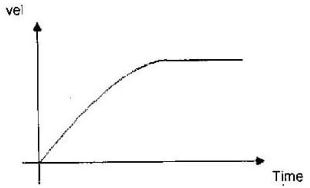
- Force upward = 600N, Force downward = 50N (wt).Therefore Net force = 550N upwards.
F= ma = m(v-u)/t = m(v)/t since u= 0
550 = (50 x v)/0.1
V = 11m/s -
-
- The body continues in its uniform state of motion velocity
- U= 25 m/s, V=0, S= 20m a=?
V2 = U2 + 2as
0= 625 + 40a
a= -15.625m/s2
F= ma = 800x – 15.625
= -12500N
Therefore decelerating force= 12500N
- Since one is moving towards the other one is +ve while the other is –ve.
Momentum before collision = momentum after collision- M1u1 + m2u2 = (m1+m2) v
(2x 0.25) – (1.5 x 0.4) = 3.5 x v
0.5 – 0.6 = 3.5 v
v= -0.02867m/s
= -2.867 x10-2m/s - The original direction of the 1.5kg mass
- M1u1 + m2u2 = (m1+m2) v
-
-
-
-
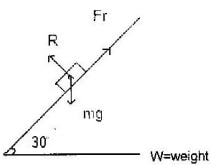
Fr= Frictional force - Force= mgsin 30 − 6
= 5 x 10 x 0.5 − 6
= 19N - F= ma
19=5a = a = 3.8m/s2
U= 0 m/s
S= 0.25m
t =?
s= ut + ½ at2
0.25 = 0+ 1.9t2
t2 = 0.3627s
= 0.36s
-
-
- Plot the graph
- Let it touch y and x – axis
- Time taken by bullet = x intercept (30ms)
- Impuse = force x time = area bound between x – axis and the line of the graph (6Ns)
- V= 200m/s m=?
Impulse = Ft = Mv – Mu
= 6Ns = M x 200-0 since u= 0
Therefore m= 0.03kg
-
- M tends to remain in its state of uniform rest due to its inertia. This protects string A
- Propelling force= 0.5 x 10= 5N
Opposing force= frictional force = 3 N
Net Force = 5-3 = 2N
Using F= ma
2= (2+ 0.5)a
a= 0.8m/s2
s= 0.6m
u=0
V2 = U2 + 2as
= 0+ 2+ 0.8 + 0.6
= 0.96
Therefore V= 0.9798
V= 0.098m/s - Speed decrease. Since momentum before collision is equal to momentum after collision i.e M1V1 = M2V2 then increase in mass implies/cause a decrease in velocity.
-
-
- R=Reaction
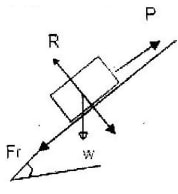
- Mg sin 10 = 30 x 10 sin 10
= 52.1 + 20 - Since the velocity is constant then the net force = 0
p= mgsinӨ + Fr
p= 52.1 + 20
= 72. 1N
- R=Reaction
-
- Frictional force
- F= ma
(52.1 − 2.0) = 30a
32.1 = 30a
a = 1.07 m/s2
-
- The mattress increase time taken to land. Thus from
f= (Change in momentum)
Time taken
When time is more the force that will decelerate the jumper will be smaller (safer) - Fr= frictional force
F= ma
F= 2ma
Dividing
1 = a1
2a2
i.e. a2 = (½)a1 OR read the value of x- intercept i.e. when a=0 m=mo and substitute in the equation to get m. - Since one is moving towards the other one has +ve vel while the other is –ve
Momentum before collision = momentum after collision- m1u1 + m2u2 = (m1m2)v
(2 x 0.25) − (1.5 x 0.4) = 3.5 x v
0.5 – 0.6 = 3.5 v
V= 0.02867m/s
= -2.867 x 10-2 m/s - The original direction of the 1.5 kg mass
- m1u1 + m2u2 = (m1m2)v
-
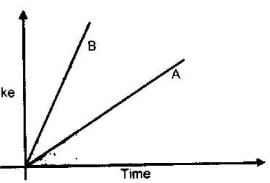
- Speed decreases. Since momentum before collision is equal to momentum after collision i.e. M1V1 = M2V2 then increase in mass implies/cause a decrease in velocity.
-
- A body at rest or in motion at uniform velocity tends to stay in that state unless acted on by an unbalanced force.
-
- Slope s= 97.5 - 0 (m/s2)
16 - 0
20k = s = 6.09 - k = 6.17/20 = 0.304
- Increase in roughness increase k and vice versa
- Slope s= 97.5 - 0 (m/s2)
- Applying equation
V2 – U2 = 2as
V2 – 0= 2 x 1.2 x 400
Momentum P = mv
= 800 x √(2 x 1.2 x 400)
= 24787.09
= 24790 (table)
- 2N
- 7.75m/s
- 2415N
-
- 5.4m
- 0.66N
-
- 10m/s,
- -3.33m/s,
- 0.333
-
- 50,000J
- 875N
-
- 7.07 m/s, 0.71s,
- 0.071kgm/s (ii) 0.71N (iii) 0.71N
- 30000N
Join our whatsapp group for latest updates
Tap Here to Download for 50/-
Get on WhatsApp for 50/-
Download Newton's Laws of Motion Questions and Answers - Physics Form 3 Topical Revision.
Tap Here to Download for 50/-
Get on WhatsApp for 50/-
Why download?
- ✔ To read offline at any time.
- ✔ To Print at your convenience
- ✔ Share Easily with Friends / Students

